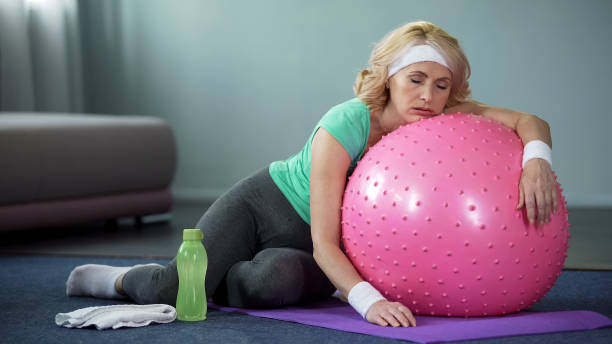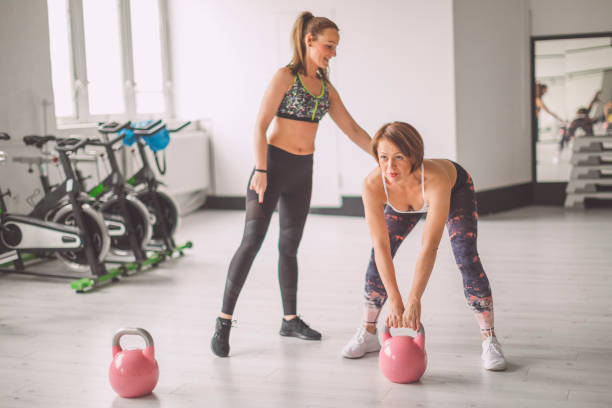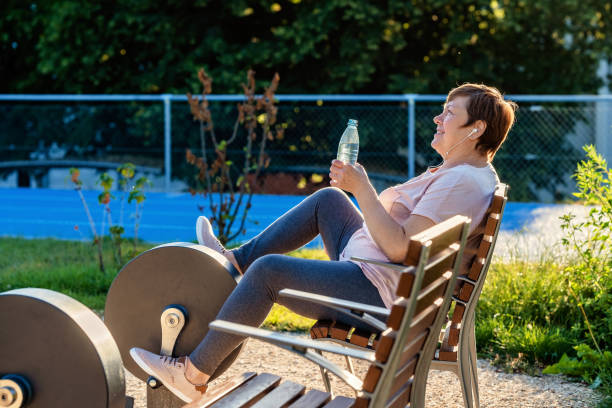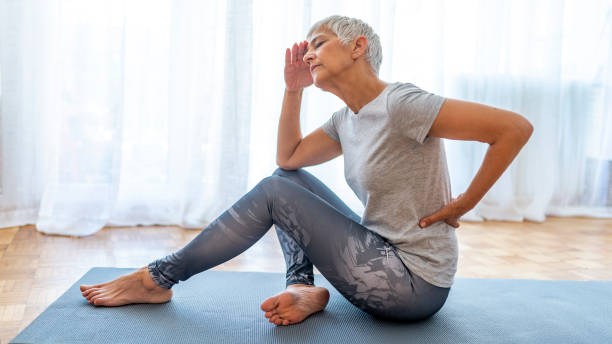Mastering Menopause: Unlock Your Ultimate Workout Potential with These Expert Tips
So you’ve hit menopause? Bravo! You have a host of reasons to celebrate this milestone!
First off, you’ve bid farewell to those nagging period cramps. And you don’t have to worry about unplanned pregnancies anymore.
As expected, your estrogen and progesterone hormone levels have slumped since your last period. Consequently, your body is more susceptible to wide-ranging health issues. The top culprits include osteoporosis, anxiety, hot flashes, sarcopenia, and cardiovascular events.
If you don’t manage these issues, they will wreak havoc in your life. But we have good news for you – you can mitigate them using exercise.
Research reveals that, unlike less active women, older women engaging in moderate physical activity experience mild symptoms and are less susceptible to menopause-related issues. While exercise alleviates these problems, it is important to note that some exercises might be inappropriate or ineffective.
At Kloudiron, we understand your concerns, so we have put up an informative guide to help you stay in shape in menopause.
Read on to learn how to chart your way to fitness and keep menopause-related issues at bay.

Fitness Challenges Facing Women in Menopause
Menopause is a natural biological process that marks the end of your reproductive years.
During this time, your body undergoes hormonal changes that can lead to weight gain, decreased muscle mass, and loss of bone density. These changes can make it more difficult for women to stay active and maintain their physical health.
Weight Gain
Among the biggest fitness challenges facing women in menopause is weight gain.
As hormone levels change, metabolism slows down, and your body tends to store more fat. This can lead to an increase in body weight, which can be frustrating for women trying to maintain a healthy lifestyle.
Menopause can also lead to a decrease in muscle mass, which can further slow down metabolism and make it harder to burn calories.
Decreased Bone Density
Another challenge facing women in menopause is a decrease in bone density.
As estrogen levels decline, women are at greater risk for osteoporosis, a condition in which bones become weak and brittle. This can make it more difficult to engage in high-impact activities like running or jumping, which can strain the bones and increase the risk of fracture.
Despite these challenges, there are many ways for women in menopause to stay fit and active.

Sweating through Menopause: Your Roadmap to Optimal Fitness and Well-Being
Exercising during menopause requires a meticulous approach. To optimize your workout results;
Start Slow
Once you enter menopause, your body will thank you for engaging in regular physical activity. But if you begin with high-intensity training, you might suffer injuries or burnout.
One of the primary reasons why women in menopause should start slow on their workout routine is because their bodies are experiencing significant hormonal changes. These changes can impact everything from bone density to muscle mass. Starting slow and gradually increasing the intensity and duration of your workouts can help you avoid injury and ensure that you’re making progress without putting too much strain on your body.
Another reason why starting slow on your workout routine is so important is that many women in menopause are dealing with other health issues as well. For example, women in menopause are at increased risk for developing conditions like osteoporosis and heart disease. By starting slow and gradually building up your strength and endurance, you can reduce your risk of these and other health problems.
In addition to the physical benefits of starting slow on your workout routine, there are also psychological benefits to consider. Many women in menopause experience mood swings, anxiety, and depression, all of which can be improved by regular exercise. However, if you push yourself too hard too quickly, you may end up feeling overwhelmed and discouraged. By starting slow and taking a gradual approach to exercise, you can build confidence and set yourself up for long-term success.
So, what does starting slow on your workout routine look like in practice? Here are a few key things to keep in mind:
- Start with low-impact exercises like walking, swimming, or cycling. These exercises are easy on your joints and can help you build endurance without putting too much strain on your body.
- Focus on building strength gradually. Start with lighter weights and fewer reps, and gradually increase the weight and number of reps over time.
- Listen to your body. If you start to feel pain or discomfort, take a break and give yourself time to recover before jumping back in.
- Be patient. It can be frustrating to feel like you’re not making progress quickly enough, but remember that slow and steady wins the race. By taking a gradual approach to exercise, you’ll be more likely to stick with it over the long term and see the results you’re looking for.

Prioritize Building Muscle
Among the key things to focus on when starting an exercise routine in menopause is building muscle. This may seem counterintuitive, especially if weight loss is your primary goal, but there are several reasons why muscle-building should be a top priority.
First, muscle is more metabolically active than fat — the more muscle you have, the more calories you burn even when at rest. This is important because upon hitting menopause, your metabolism naturally slows down, making it more difficult to lose weight. Building muscle can help counteract this effect and keep your metabolism revved up.
Second, muscle-building can help prevent bone loss, a common concern for women in menopause. As estrogen levels decline, bones can become weaker and more prone to fractures. Strength training exercises, which focus on building muscle and bone density, can counter bone loss.
Third, building muscle can improve your overall physical function and reduce the risk of falls and other injuries. As you age, your balance and coordination can decline, making you more susceptible to falls. Strength training can help improve these factors and reduce the risk of falls.
So how do you go about building muscle?
The most effective way is through strength training exercises like weight lifting or resistance band exercises. Perform these exercises at least twice a week, with a focus on working all major muscle groups. Advisably, start with light weights or resistance and gradually increase over time to avoid injury.
In addition to strength training, consider incorporating cardiovascular exercises into your routine. This can include activities like brisk walking, cycling, or swimming, which help improve heart health and burn calories. For the best results, aim for at least 30 minutes of moderate-intensity exercise most days of the week.

Leverage Balance and Stability Training
Training for balance and stability is so important for women in menopause. First and foremost, as you age, you become more susceptible to falls and other accidents. By training for balance and stability, you can improve your overall coordination and reduce the risk of falls.
Another benefit of training for balance and stability is that it can help you maintain your independence as you get older. As you age, you may find that you can no longer do the things you once did without assistance. This can be a difficult and demoralizing experience, and many women find that it takes a toll on their mental health. By staying active and training for balance and stability, you can maintain your independence for longer and continue to live life on your own terms.
Training for balance and stability can also improve your bone health. By engaging in weight-bearing exercises focusing on balance and stability, you can strengthen your bones and reduce their risk of fractures.
Training for balance and stability can be a great way to improve your overall fitness levels and feel better about yourself. Remember, menopause can be a challenging time, both physically and emotionally. By staying active and exercising regularly, you can improve your mood, boost your energy levels, and feel more confident in yourself and your abilities.
So what kinds of exercises should women in menopause focus on if they want to train for balance and stability? There are many different options to choose from, including yoga, Pilates, and Tai Chi. These forms of exercise are low-impact and can be adapted to suit a range of fitness levels and abilities.
In addition to these more traditional forms of exercise, you can also incorporate balance and stability training into your daily activities. This might include things like standing on one leg while brushing your teeth or doing squats while waiting for the kettle to boil. By making small changes to your daily routine, you can improve your balance and stability over time.

Embrace Cardio
Cardio exercises can help you lose weight and maintain a healthy body weight. With age, your metabolism slows down, and it can be more challenging to shed excess pounds. However, engaging in cardio exercises like running, cycling, or swimming can help you burn calories and boost your metabolism, making it easier to maintain a healthy weight.
Cardio exercises can also alleviate hot flashes and night sweats, two of the most common symptoms of menopause. These symptoms can be incredibly uncomfortable, making it challenging to get a good night’s sleep or focus on daily activities. However, regular cardio exercise has been shown to reduce the frequency and intensity of hot flashes and night sweats, making them less disruptive to your life.
In addition to these benefits, cardio exercises can also help improve your heart health, lower your blood pressure, and reduce your risk of developing chronic diseases like diabetes and heart disease.
If you’re ready to incorporate cardio exercises into your daily routine, there are a few things to consider. First, start slowly and gradually increase the intensity and duration of your workouts over time. This will help you avoid injury and ensure you get the most out of your workout.
Secondly, choose exercises that you enjoy and that fit into your lifestyle. If you hate running, don’t force yourself to do it. Instead, try cycling, swimming, or dancing. The key is to find an activity you enjoy and stick to over the long term.
Most importantly listen to your body and take breaks when you need them. Since you are aging, your body may not be able to handle the same level of intensity as it could in your younger years. So, if you feel tired or sore, take a day off or do a lighter workout. Your body will thank you for it.

Listen to Your Body
As a woman navigating menopause, listening to your body is crucial when embarking on a fitness journey. Your body undergoes unique changes during this time, and tuning into its signals helps prevent injury and optimize results.
To avoid burnout and injury, pay attention to energy levels, joint discomfort, and overall well-being.
By honoring your body’s cues, you can tailor workouts to suit your needs, ensuring a safe and effective path toward improved fitness and overall wellness during menopause.

The Bottom Line
Menopause can present unique challenges for women trying to stay fit and active. However, with the right approach, it is possible to maintain a healthy lifestyle and enjoy all the benefits of regular exercise and proper nutrition. By starting slowly, choosing enjoyable activities, and working with qualified professionals, you can stay fit, healthy, and happy for years to come.
When starting an exercise routine, it’s important to start slowly and gradually increase intensity over time. This can help to prevent injury and allow the body to adjust to the new demands being placed on it. It’s also important to choose activities that are enjoyable and sustainable.
In addition to exercise, proper nutrition is also important for women in menopause. Eating a balanced diet rich in fruits, vegetables, whole grains, lean proteins, and healthy fats can help to support overall health and wellness. It’s also important to stay hydrated by drinking plenty of water throughout the day.
Looking to stay healthy without breaking the bank? Don’t look any further.
Subscribe to Kloud Iron’s 28-day fitness program and begin your journey toward optimal mental health and physical fitness. To learn more about Kloud Iron Fitness Hub’s offers, contact us today or message/follow us on Facebook and Instagram. We are also available on YouTube.


1 Comment
бнанс бонус за рестрацю
3 months agoThanks for sharing. I read many of your blog posts, cool, your blog is very good.